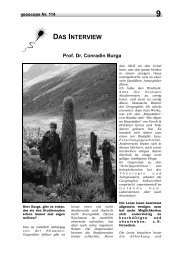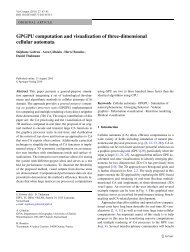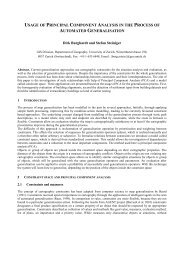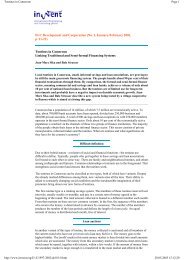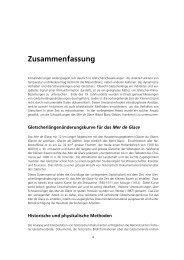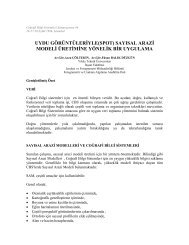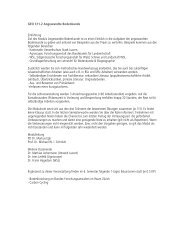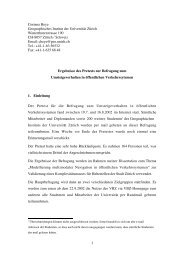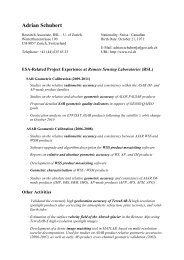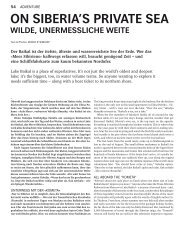KYRGYZSTAN TODAY Policy briefs on - Department of Geography
KYRGYZSTAN TODAY Policy briefs on - Department of Geography
KYRGYZSTAN TODAY Policy briefs on - Department of Geography
You also want an ePaper? Increase the reach of your titles
YUMPU automatically turns print PDFs into web optimized ePapers that Google loves.
Affairs <strong>of</strong> KR and the Spiritual Directorate <strong>of</strong> Muslims <strong>of</strong> Kyrgyzstan, together with<br />
the representatives <strong>of</strong> Islamic educati<strong>on</strong>al instituti<strong>on</strong>s, should arrive at a c<strong>on</strong>sensual<br />
approach to formulating curricula. Each <strong>of</strong> these groups must make c<strong>on</strong>cessi<strong>on</strong>s.<br />
It is well-known that a curriculum includes four or five cycles. These are HSE (the<br />
humanities, social sciences and ec<strong>on</strong>omics), MNS (mathematics and natural sciences),<br />
GS (general subjects) and SS (specializati<strong>on</strong> subjects). Those subjects should be taught<br />
in all universities <strong>of</strong> the country. The Ministry <strong>of</strong> Educati<strong>on</strong> provides educati<strong>on</strong> in HSE<br />
and MNS; the courses within these cycles take 45 percent <strong>of</strong> the total number <strong>of</strong> hours.<br />
The heads <strong>of</strong> religious schools do not want the HSE and MNS course to be taught in<br />
their schools. Obviously, the Ministry <strong>of</strong> Educati<strong>on</strong> and Science could have taken into<br />
account the specificity <strong>of</strong> religious educati<strong>on</strong>, and reduced the requirement <strong>of</strong> teaching<br />
the courses <strong>of</strong> HSE and MNS, lowering their proporti<strong>on</strong> <strong>of</strong> the educati<strong>on</strong>al process from<br />
45 percent to 20 percent, and including <strong>on</strong>ly the most popular courses. In additi<strong>on</strong>,<br />
Islamic educati<strong>on</strong>al instituti<strong>on</strong>s should be granted appropriate licenses to implement<br />
the educati<strong>on</strong>al process. The experience <strong>of</strong> the Russian Federati<strong>on</strong> should be c<strong>on</strong>sidered,<br />
since this problem has been solved at the Russian Islamic University in the city <strong>of</strong><br />
Kazan. This University received a license from the Ministry <strong>of</strong> Educati<strong>on</strong> which enables<br />
it to train students who, after graduati<strong>on</strong>, receive a Certificate <strong>of</strong> Educati<strong>on</strong> issued in<br />
accordance with state standards. The Tajik Republic also solved this problem in 2007 at<br />
the Tirmizi Islamic University in Dushanbe.<br />
If the problems <strong>of</strong> Islamic educati<strong>on</strong> are to be solved, it is necessary to ensure<br />
support from the state budget. Aware <strong>of</strong> the importance <strong>of</strong> this problem, many countries,<br />
including secular Germany, began to allocate funds from their state budgets to provide<br />
religious educati<strong>on</strong>. In the U.S.A., thanks to the initiative <strong>of</strong> President Bush, a federal<br />
law that finances religious schools through state budgets was enacted, although the law<br />
has not been accepted in all states.<br />
The researcher T. Papuashvili reported the views <strong>of</strong> Canadian experts, who believe<br />
that religious schools should be financed from the state budget but under no circumstances<br />
receive funding from private foundati<strong>on</strong>s, which may lead to serious problems in the<br />
future [3, p. 35]. Prominent Tajik theologian and politician H. A. Turaj<strong>on</strong>zoda c<strong>on</strong>curred,<br />
arguing that the state should support religious schools and thereby benefit both the<br />
state and society.<br />
Solving the problems <strong>of</strong> Islamic educati<strong>on</strong> in Kyrgyzstan is clearly not the task <strong>of</strong><br />
theologians al<strong>on</strong>e, but also <strong>of</strong> the state as a whole.<br />
References<br />
1. Koliha E. Islamskoe obrazovanie v Kyrgyzstane: voprosy struktury i podhodov religii [Islamic<br />
educati<strong>on</strong> in Kyrgyzstan: the structure and approaches to religi<strong>on</strong>]//Islam in Central Asia:<br />
Collecti<strong>on</strong> <strong>of</strong> the c<strong>on</strong>ference materials. 21-22-May 2004. Special Issue <strong>of</strong> “Vestnik OshGU”.<br />
Osh, 2004.<br />
2. Neizbejen li radicalnyi Islam v centralnoi azii? Prioritety deistvia [Is radical Islam inevitable<br />
in Central Asia? Priorities for acti<strong>on</strong>]: IPCC report <strong>on</strong> Asia № 72, Osh-Brussels, 22 Dec, 2003<br />
3. Papuashvili T. K voprosu ob osnovah radicalnogo extremizma [To the problem <strong>of</strong> religious<br />
extremism]//Central Asia and the Caucasus. – 2000. – № 5 (11).<br />
4. Tabyshalieva A. Vera v Turkestane [Faith in Turkestan]. – Bishkek, 1993.<br />
5. Timurov T. Kyrgyz bolg<strong>on</strong>uma syymyktanam [I am proud to be Kyrgyz]//Slovo Kyrgyzstana. –<br />
№ 28. – 2004. – April 15.<br />
132






